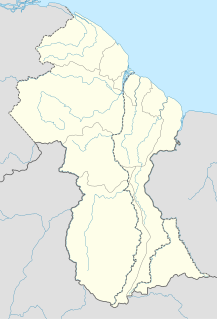Tiriyo, Tiriyó, or Trió may refer to:
British may refer to:
English usually refers to:
Italian may refer to:
Trio may refer to:
Est, EST or Est. may refer to:
Begin or Bégin may refer to:
Church may refer to:
JBT may refer to:
Zebra is one of several species of the horse genus Equus whose members have distinctive stripes.
Emphasis or emphatic may refer to:

The Tiriyó are an Amerindian ethnic group native to parts of northern Brazil, Suriname, and Guyana. In 2005, there were approximately 2,761 Tiriyó in the three countries. They live in several major villages and a number of minor villages in the border zone between Brazil and Suriname. They speak the Tiriyó language, a member of the Cariban language family and refer to themselves as tarëno, etymologically 'people from here' or 'local people'.

Kwamalasamutu, also Kwamalasamoetoe, is a Tiriyó Amerindian village in southern Suriname, and home to the granman of the northern Trios. Kwamalasamutu is the biggest village of the Tiriyó tribe.

Pelelu Tepu is a small Amerindian village in the interior of Suriname. Also known as "Pe'reru Tepu", the village is typically referred to simply as "Tepu," which mean "high" in the Indian Tiriyó language. The village is located on Tepu hill, on the Tapanahoni River. Though inhabited by Amerindian tribes indigenous to the area, the village was created by Christian missionaries and (primarily) Tiriyó Indians, though it now also includes small numbers of Wayana and Akuriyo Indians. The village has a tribal organization, led by a Trio Captain.
Tiriyó is the Cariban language used in everyday life by the Tiriyó people, the majority of whom are monolingual. Although Tiriyó is the preferred spelling, the Tiriyó refer to themselves as tarëno; other variations, including tarano, tirió, and trio, exist. The Tiriyó are located on both sides of the Brazil-Suriname border in Lowland South America. Because Tiriyó is spoken by the entire Tiriyó population, its level of endangerment is low. However, it may be threatened by the presence of a newly installed radar station staffed by a considerable number of non-Indigenous people close to the main village.
Bella is a feminine given name and a surname.
Ndyuka-Tiriyó Pidgin (Ndyuka-Trio) was a trade language used until the 1960s between speakers of Ndyuka, an English-based creole, and Tiriyo and Wayana, both Cariban languages.
Carib Pidgin may refer to:

Amatopo or Amotopo is a Tiriyó village on the Courentyne River in the Sipaliwini District of Suriname. The village lies next to the Amatopo Airstrip and about 7 kilometres (4.3 mi) upstream the Courentyne River from the village of Lucie.

Wanapan or Arapahtë pata is a Tiriyó village in the Sipaliwini District of Suriname. It was established at the bottom of the Wonotobo Falls in 1998 by captain Arapahtë.

Kasuela is an indigenous village of the Tiriyó people in the East Berbice-Corentyne region of Guyana. The village has a population of about 80 people. The inhabitants are of the subgroup Mawayana or the Frog people. There are a little over 100 Mawayana Tiriyó in the world.